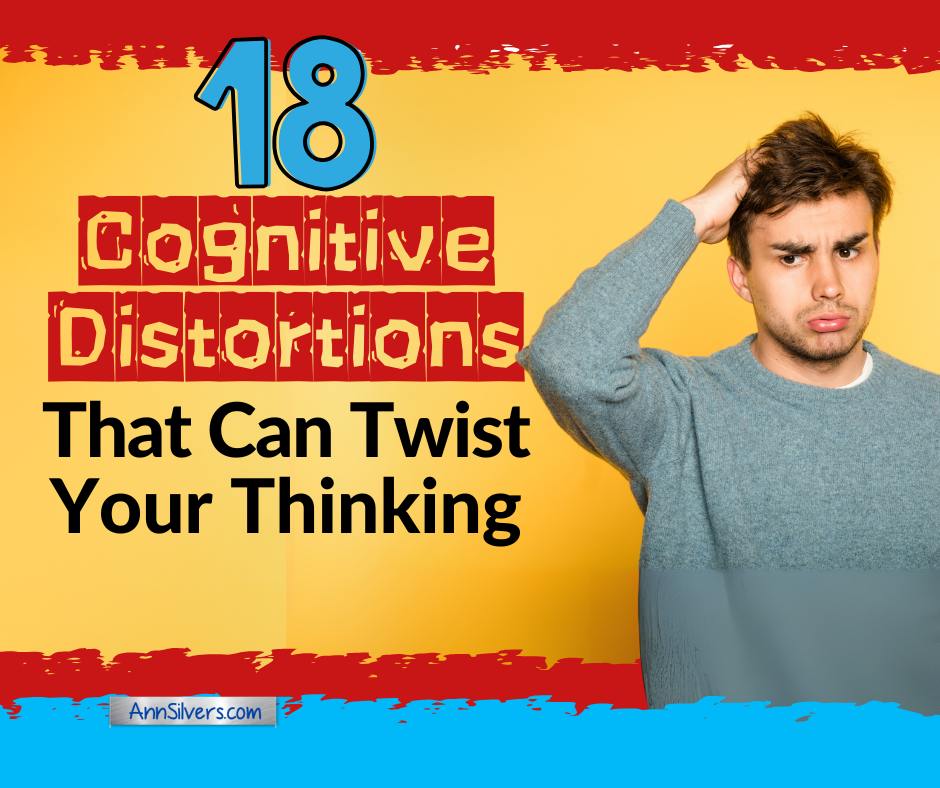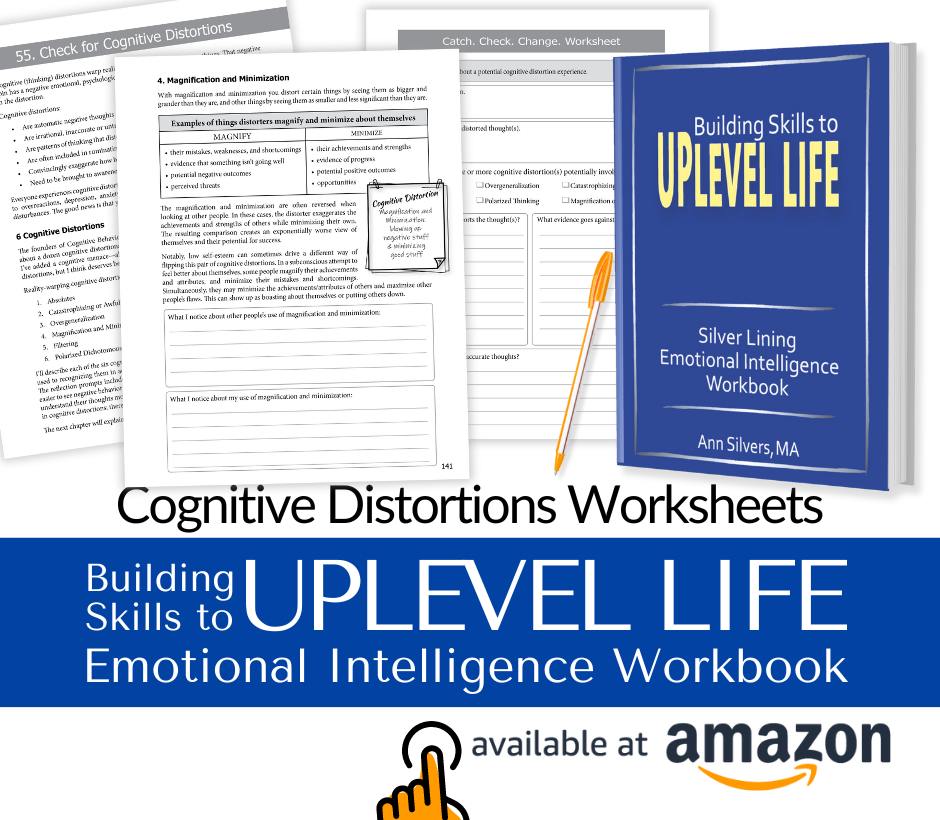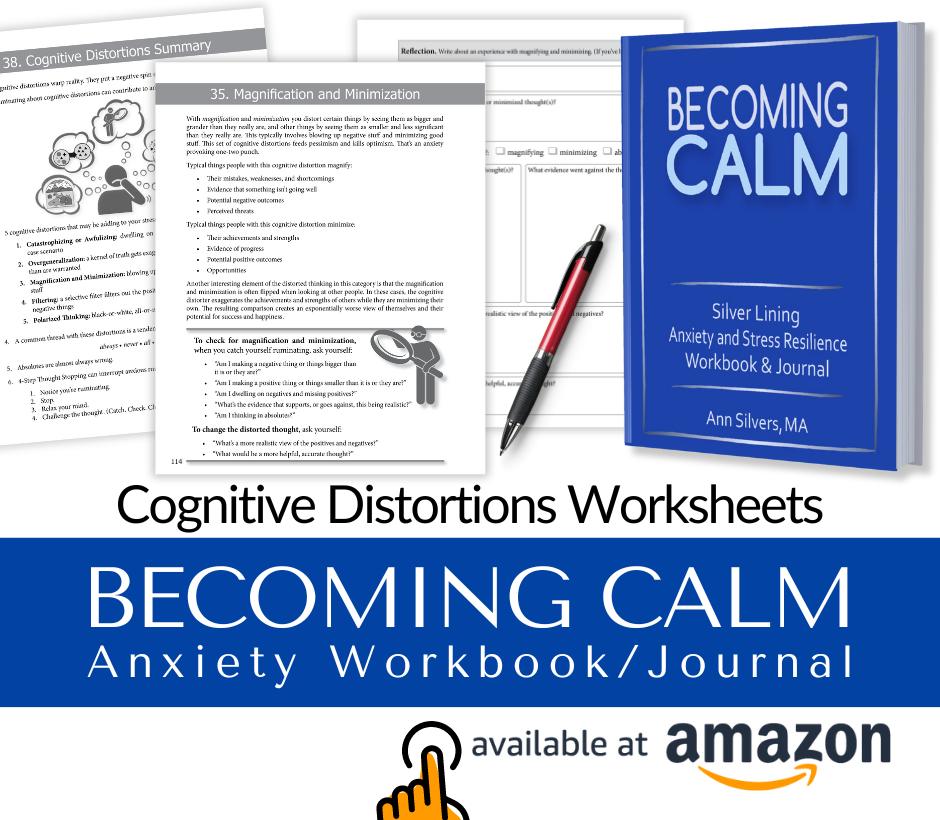18 Cognitive Distortions That Can Twist Your Thinking

Cognitive distortions are negative thinking patterns that twist how you see yourself, others, and the world around you. They create a negative narrative that distorts reality and makes things seem worse than they are.
The concept comes from Cognitive Behavioral Therapy (CBT), where these kinds of distorted thoughts have been identified as major contributors to stress, anxiety, depression, anger, low self-esteem, and relationship issues.
Over time, the list of cognitive distortions has changed a lot. As it's been added to and altered, some appear more often in online discussions than in therapy textbooks. There’s no single definitive list.
I pulled together this list to provide explanations and examples for negative thought patterns that I've repeatedly seen labelled as cognitive distortions.
Do I think all 18 deserve to be on the list?
Not really—and I’ll point out why as we go.
Still, each one represents a way thinking can become distorted, and something on the list might help you notice a negative mind trap you hadn’t spotted before.
👉 Throughout this post, I’ll highlight resources you can use to identify and shift distorted thinking—whether you're trying to reduce anxiety, improve emotional regulation and relationships, or just develop a more balanced perspective.
What's in This Post
| What Are Cognitive Distortions? |
| Absolutes: A Cognitive Distortion Contributor |
| 18 Cognitive Distortions List with Examples |
| CBT Cognitive Distortions Worksheets: Tools to Help You Spot and Shift Distorted Thinking |
My Etsy shop, AnnSWellnessDigitals includes a CBT workbook series with mini-workbooks on cognitive distortions and other cognitive behavioral therapy and coping skills topics.
Two of my print workbooks, Becoming Calm and Uplevel Life, address cognitive distortions and many more topics with tips, techniques, and worksheets to make your life better.
What Are Cognitive Distortions?
Cognitive distortions are thinking habits that take your thoughts in a negative direction.
They show up as automatic negative thoughts (ANTs): quick, reactive thoughts that sound true in the moment, but are exaggerated and unhelpful.
These distorted ways of thinking can cause you to overreact, lose confidence, or expect the worst, even when the situation doesn’t call for it.
When you dwell on them, they fuel negative rumination—those repetitive thought loops that wind you up and wear you out.
Recognizing these patterns is a key part of many therapeutic approaches, including Cognitive Behavioral Therapy (CBT), because they can mess with your mood, confidence, and how you handle everyday situations.
Once you can spot the distortion, you can start shifting it.
|
For a fuller explanation of Cognitive Distortions, check out this post:
|
Absolutes: A Cognitive Distortion Contributor
Words like always, never, everything, nothing, all, or none represent absolute thinking.
There is no room left for variation.
If a person's behavior doesn't match that level of certainty, your attitude toward them will be more extreme, rigid, or hopeless than it should be.
The same goes for a situation you incorrectly tag in absolute terms.
Undeserved absolutes make things feel worse than they are: "My partner is never on time" feels worse than "My partner wasn't on time last week."
Absolute thinking may show up in statements as actual words like all or none, or just be there as a concept. For example, both of these statements could be backed by the same thoughts: "I always fail math exams" and "I fail math exams."
Some sources consider absolute thinking a cognitive distortion on its own, but here I'm separating it out as a contributor to many distortions.
Watch for absolutes (stated and suggested) as you read through the examples below.
18 Cognitive Distortions List with Examples

There are many different ways our thoughts can get distorted.
These are the cognitive distortions I've seen described in CBT-based resources and online discussions. You might recognize one—or several—that show up in your own thinking or the people around you.
For the first five on this list, I provide links to downloadable PDFs I've created for each that explain the negative thinking pattern in more detail and guide you through the CBT Catch, Check, Change method for spotting and overcoming the distortion habit.
1. Catastrophizing (a.k.a. Awfulizing)
Catastrophizing or Awfuling is dwelling on an exaggerated, worse-than-worst-case scenario.
This distortion convinces you that the most extreme, negative outcome to a situation is not only possible—but likely. The emotional impact snowballs, and soon you’re overwhelmed by a version of reality that hasn’t even happened.
Examples:
-
“I’ll never recover from this.”
-
"My son's going to learn how to drive. I'm so worried he's going to get in an accident."
-
"It's been an hour, and he hasn't texted me back. He's going to break up with me."
2. Overgeneralization
Overgeneralization turns an experience into a rule.
This distortion takes something negative and stretches it across time, situations, or your entire identity—until it starts to define anything even remotely similar.
There’s a kernel of truth behind the distorted thought, but it has been exaggerated and applied more broadly than is accurate or helpful.
Examples:
- "I didn't reach my goal this time. I never will."
-
“Spiders are dangerous.” (Reality: Some spiders are dangerous.)
-
“This relationship didn’t work out. I’m just not good at relationships.”
3. Magnification and Minimization
Magnification and minimization blows up the bad and shrinks the good.
This negative thought pattern distorts scale and importance. It makes problems or flaws seem massive and magnifies their emotional weight—while successes, compliments, or progress get brushed off as irrelevant or not good enough. You notice the good, but your mind tells you it doesn’t matter, isn’t enough, or doesn’t count.
Examples:
- “I misspoke once during my presentation. That ruins the whole thing.”
-
“Sure, I got the promotion—but it doesn’t mean much because I’ve been here so long.”
-
“I helped out, but it wasn’t a big deal—anyone could’ve done it.”
4. Mental Filtering
Mental filtering screens out positives while keeping the negatives.
This distortion uses selective attention to block out anything that went well. Your mind zones in on what’s wrong and overlooks what’s working. The good may have happened, but it doesn’t register because your mental filter doesn’t let it through.
Examples:
-
“That meeting was awful.” (Reality: Several people were engaged and expressed appreciation for how well it went.)
-
“Nobody cared about what I said.” (Reality: Three people nodded, and one followed up with a question.)
-
“Nothing good happened today.” (Reality: There were many good moments throughout the day, they just went unnoticed.)
5. Polarized Thinking (All-or-Nothing Thinking)
Polarized thinking is seeing things as all good or all bad, with no in-between.
This distortion turns life into a black-and-white picture with no greys. It eliminates the grey scale.
Other terms for this distortion are all-or-nothing, black-or-white, and dichotomous thinking.
Things are either amazing or awful, success or failure, right or wrong.
Everything becomes a pass/fail test with no partial credit. You ignore possibilities, progress, effort, or mixed outcomes—and decide it’s either a win or a total loss.
Examples:
-
“If I don’t do this perfectly, I’ve failed.”
-
“There's a right way to put dishes in the dishwasher. Everyone needs to do it my way!”
-
“If I don't choose the right class, I'll mess up the rest of my life.”
6. Disqualifying the Positive
Disqualifying the positive is dismissing good things as unimportant.
This distortion writes off or rejects positive feedback, compliments, accomplishments, or events as exceptions that “don’t count.” Even when good things happen, the mind pushes them aside to keep a negative narrative going.
Examples:
-
“They said I did a great job, but they were just being polite.”
-
“I got lucky on that test—I’m still not smart.”
-
“Sure, I made progress today, but it wasn’t that big of a deal.”
This distortion could be seen as the minimizing part of Magnification and Minimization or an element of Filtering.
7. Jumping to Conclusions
Jumping to conclusions is assuming something negative without evidence.
This distortion shows up when you make a quick judgment without facts to back it up. You become convinced someone is upset with you or that something bad is going to happen—even though you don’t really know.
Examples:
-
“They didn’t smile at me—they must be mad.”
-
“My boss scheduled a meeting. I'm in trouble.”
-
“They didn't say they loved my idea, so they must hate it.”
This negative thought pattern overlaps with many cognitive distortions since jumping to conclusions is how many distortions happen.
8. Mind Reading
Mind reading is believing you know what others are thinking (and it’s not good).
With this cognitive distortion, you assume someone else is thinking something critical, disappointed, or rejecting. And convince yourself it is a for-sure thing.
Examples:
-
“She hasn’t laughed at my jokes today. She must think I’m boring.”
-
“He looked at me weird. He’s probably judging me.”
-
“They didn’t invite me because they don’t like me.”
This form of negative thinking is sometimes presented as a subcategory of jumping to conclusions.
9. Fortune Telling
Fortune telling is predicting a negative future with certainty.
This distortion assumes the worst is going to happen—before anything has actually happened. It turns uncertainty into doom and makes it hard to stay hopeful or problem-solve.
Examples:
-
“I know I’m going to fail this interview.”
-
“This trip is going to be a disaster—I just know it.”
-
“Why bother trying? It’s not going to work out anyway.”
Catastrophizing also seems to cover this type of negative thought.
10. Emotional Reasoning
Emotional reasoning is believing something must be true because it feels true.
With this distortion, feelings are treated as facts. If you feel anxious, you assume something must be wrong. If you feel insecure, you assume you’re inadequate. It confuses emotion with evidence.
Examples:
-
“I feel overwhelmed, so I must not be able to handle this.”
-
“I feel like a failure—so I must be one.”
-
“I feel guilty, so I must’ve done something wrong.”
11. Should Statements
Should statements are rigid rules you place on yourself or others.
These thoughts that start with "should" or "must" create unrealistic expectations that lead to guilt, pressure, and disappointment.
They may seem like motivation, but often create stress or resentment when life doesn’t follow your rules.
Examples:
-
“I should be further along in life by now.”
-
“They should know what I need without me having to say it.”
-
“I must always be in control—anything less is failure.”
A great saying has come out of the recognition of this flawed thinking: Don't should on yourself.

12. Labeling and Mislabeling
Labeling and mislabeling makes extreme negative judgements about yourself and others.
Instead of describing specific behavior or situations, this distortion slaps on a harsh, global label—like “idiot,” “loser,” or “selfish.”
Examples:
-
“I forgot one thing—I’m such an idiot.”
-
“He was late again—what a selfish jerk.”
-
“I messed up—I’m a total failure.”
This distortion is a form of Overgeneralization that targets people—defining someone’s entire character by a small sample of mistakes or flaws.
13. Personalization and Blame
Personalization and blame is taking too much, or too little, responsibility.
You either believe everything is your fault, or you place full blame on others.
Examples:
-
“They’re upset—it must be because of something I did.”
-
“The event didn’t go well. I should’ve done more to fix it.”
-
“None of this would’ve happened if they weren’t so difficult.”
14. Tunnel Vision
Tunnel vision is only seeing what’s wrong and ignoring what’s right.
This distortion blocks out the good and highlights what’s wrong. You get stuck on flaws or problems, even when there’s plenty of positive happening too.
Examples:
-
“This whole week has been terrible,” even though only one day was stressful.
-
“That presentation was a disaster,” ignoring the strong start and positive feedback.
-
“My partner is so annoying lately,” forgetting the moments of support or kindness.
This one seems parallel to Filtering to me.
A Note About the Fallacy Distortions
Before we move into the final group of cognitive distortions, I want to pause and say a few words about these next entries.
Each has fallacy in its title.
Compared to the distortions already mentioned, I see the fallacies more as beliefs or worldviews.
In therapy, I approach these differently. If a fallacy seems to be influencing someone’s thinking, I help them explore the belief and consider whether it might be worth adjusting their outlook.
Even if I would treat the thought fallacies differently than other cognitive distortions, they are included here for completeness. You may find that learning about them provides useful insights for personal growth.
15. Fallacy of Fairness
The Fallacy of Fairness is believing life should always follow your personal rules about what’s fair.
This distortion shows up when you expect others—or the world—to behave in a way that matches your internal fairness scale, and you get very upset when it doesn't work out that way.
Reality: Life is sometimes not fair.
Examples:
-
“I’m always kind to people. Why don’t I get the same in return?”
-
“Other people get support—I shouldn’t have to do everything alone.”
-
“They got the job even though I had more experience. That shouldn’t happen.”
16. Fallacy of Change
The fallacy of change is believing someone else has to change so you can feel better.
This distortion outsources your happiness. It puts your focus on how others need to act differently before you can feel okay, instead of working with your own responses or needs.
Examples:
-
“If my partner would just listen better, I wouldn’t get so upset.”
-
“My boss needs to stop micromanaging so I can enjoy work again.”
-
“Until my family stops criticizing me, I won’t be able to move forward.”
17. Control Fallacies
Control fallacies is either believing you have total control or no control.
This distortion has two potential sides:
-
Total control: You believe you’re responsible for everything—including how others think, feel, or behave.
-
No control: You believe you’re powerless, with no ability to influence your situation or choices.
Both extremes distort your sense of influence and make it harder to respond flexibly to life’s challenges.
Examples:
Total control fallacy:
-
“If they’re upset, it must be because of something I did.”
- “I have to fix this situation or it’s all on me.”
No control fallacy:
- “There’s nothing I can do—this is just how life is.”
- “It doesn’t matter what I try. Things never work out for me.”
18. Heaven’s Reward Fallacy
Believing the world should always reward what’s “right.”
This distortion centers on believing that if you try hard, sacrifice, or act morally, life should eventually “pay off.”
It’s the belief that if you’re good, loyal, or selfless enough, life will eventually “pay you back.” When that doesn’t happen, disappointment and bitterness follow.
Examples:
-
“I’ve sacrificed so much—why isn’t anything getting better?”
-
“I always help others. Why doesn’t anyone show up for me?”
-
“I followed all the rules. Why am I still struggling?”
CBT Cognitive Distortions Worksheets: Tools to Help You Spot and Shift Distorted Thinking
Cognitive distortions come up in therapy a lot.
They are such a common issue, and addressing them is such an important part of improving personal and relationship well-being that I've created two sets of products for you to learn more about cognitive distortions and use the Catch, Check, Change method to challenge them: Downloadable targeted PDFs and Print Workbooks for anxiety and emotional intelligent life.
1. Cognitive Distortions Downloadable PDF Worksheet Workbooks
My downloadable pdf CBT workbook series, available on my AnnSWellnessDigitals Etsy shop, includes information pages with tips and techniques and worksheets for 5 cognitive distortions.
- Individual Cognitive Distortion Workbooks: Catastrophizing or Awfulizing, Overgeneralization, Magnification and Minimization, Mental Filtering, and Black-and-White, Polarized Thinking. Each workbook can be printed or used digitally on your devices as fillable forms.
- Cognitive Distortion Bundle: This 28-page Cognitive Distortions CBT Coping Skills Workbook printable PDF bundle covers all five of the cognitive distortions. Note: This one is formatted for print only, not as a digital fillable form.
2. Emotional Intelligence and Anxiety Print Workbooks
Prefer a physical workbook or looking for something that covers more topics? Two of my printed books include full sections on distorted thinking and how to respond more effectively:
Building Skills to Uplevel Life: Silver Lining Emotional Intelligence Workbook
Becoming Calm: Silver Lining Anxiety and Stress Resilience Workbook and Journal
👉 Start your journey to emotional intelligence and resilience! These workbooks offer tools to help you develop skills, reduce stress, and foster personal growth. Check them out and take the next step toward a calmer, more balanced life.
Note: This post should not be taken as therapy. It is always advisable to seek individualized care with a mental health professional.
- Ann Silvers













Comments 0